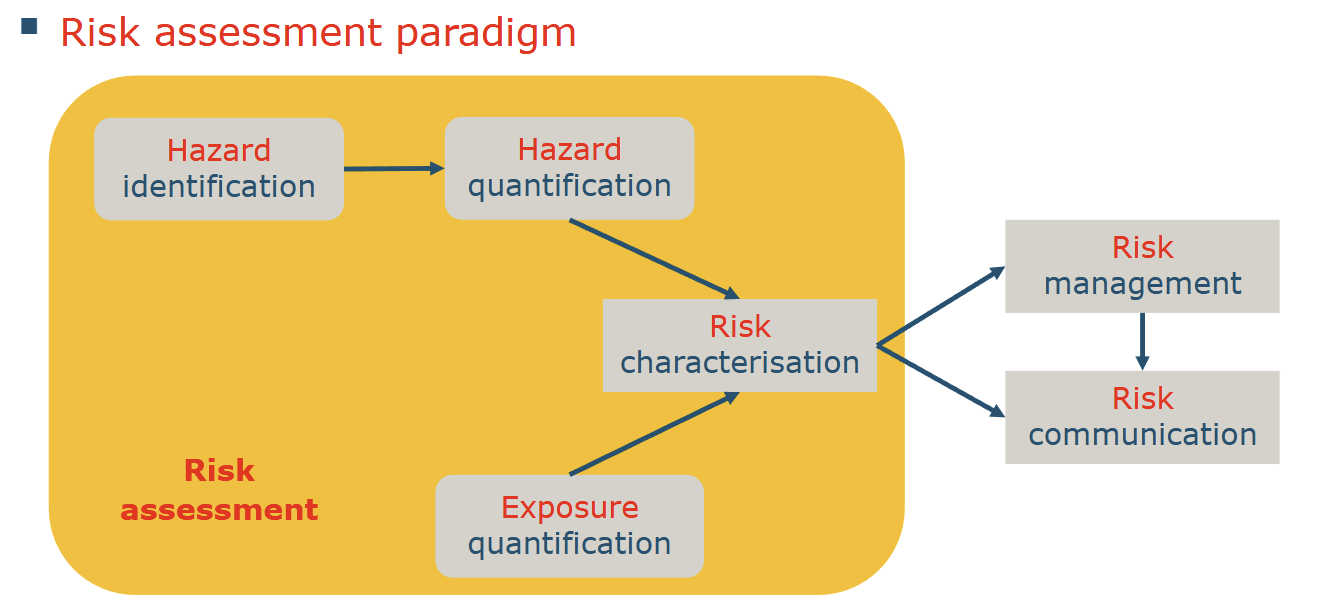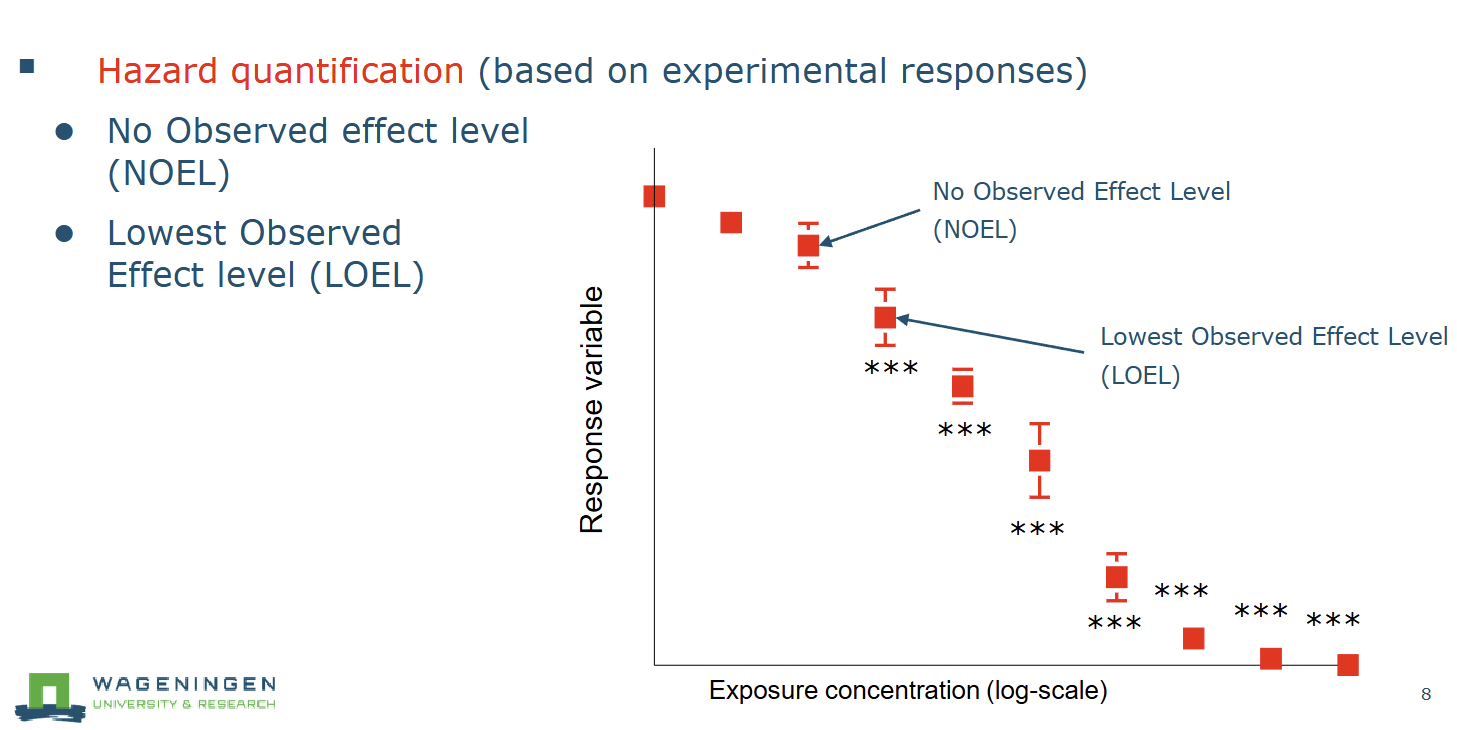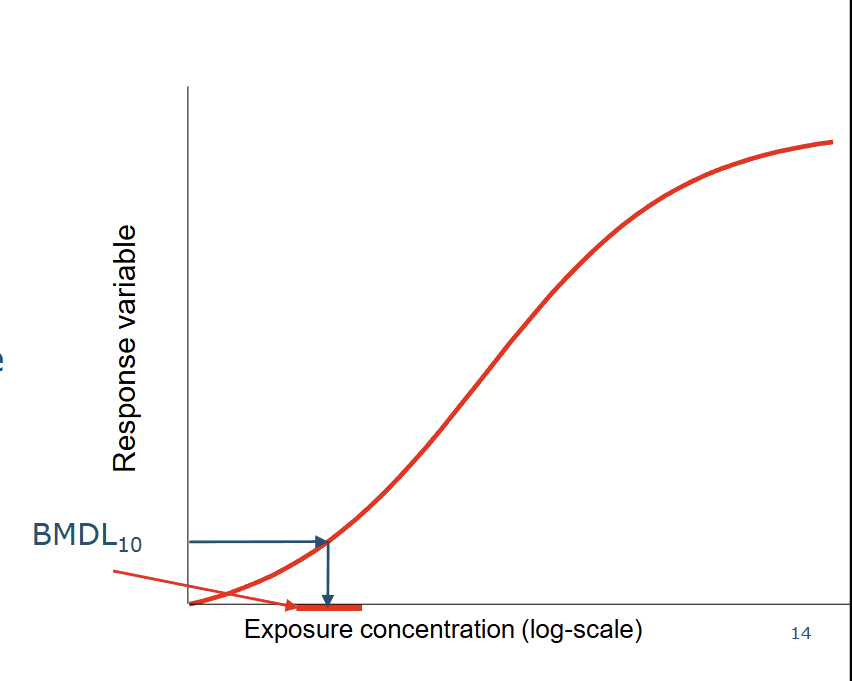lecture 2- risk assessment: human and environmental
what are the 2 parts of risk assessment
Risk assessment
• Hazard characterisation
• Exposure assessment
what does risk assessment involve
Risk assessment involves determining the probability (risk) that a hazard (the potential effect of a chemical) might happen, considering exposure
1/26
There's no tags or description
Looks like no tags are added yet.
Name | Mastery | Learn | Test | Matching | Spaced |
|---|
No study sessions yet.
27 Terms
what are the 2 parts of risk assessment
Risk assessment
• Hazard characterisation
• Exposure assessment
what does risk assessment involve
Risk assessment involves determining the probability (risk) that a hazard (the potential effect of a chemical) might happen, considering exposure
describe risk assessment, risks on what?what is it we need to protect
● Human protection goals
● Individual well being (physical/mental development,
health, longevity, ...
● Environmental protection goals
● Viable populations/ecosystems
● Healthy environment for food production, living,
recreation, drinking water, nature
Physical development: embryonic/developmental/teratogenic toxicity
● Endocrine disruption, genotoxicity, developmental effects, ...
Mental/motoric development
● Neurotoxicity, brain development, anti-depressants, ...
Longevity, age related effects
● Genotoxicity, antidepressants, lethal effects, ...
Reproduction
● Endocrine disruption, behavioural development, ..
Hazard Identification
Hazard Identification: What harmful effects can the chemical cause? This is often based on the Mode of Action (MOA), how the chemical exerts its effects at a biological level, like non-covalent binding to ligands (receptor binding) as seen with dioxins
hazard characterisation
Hazard characterisation
• Identification: which effects to be expected?
• Quantification: at what levels relevant?
Hazard Quantification
Hazard Quantification: At what levels or concentrations does the chemical cause these harmful effects? This uses dose-response curves from experiments
exposure assessment
Exposure assessment
• Quantification of actual or modelled exposure
Exposure Quantification: How much of the chemical are organisms exposed to
draw the risk assessment paradigm

describe hazard identification
Hazard identification (based on Mode of Action)
● What biochemical effects to be expected: Neurotoxic, immunotoxic,
genotoxic, developmental toxic, .......
● What adverse outcomes to be expected: mortality, reproduction,
development, longevity, ...
● Relevance of effects: human versus environmental risks
describe hazard quantification based on dose response curve
Hazard quantification (based on dose response curve)
● What level of identified effect is acceptable?
● Definition of threshold levels to be used to interpret exposure
● NOEL, LOEL, BMDLx, ECx, xxx
describe hazard quantification based on experimental responses

what is NOEL and LOEL
Highest concentration with no significant effect – NOEL
Lowest concentration with a significant effect-LOEL
Human hazard quantification what are the two types
1- non genotoxic compounds
2- genotoxic compounds
what do you apply for non genotoxic compounds
Non-genotoxic compounds: apply NOEL, BMDLx
ECx
EC50
EC10
BMDx
BMDL10
ECx (Effect Concentration x), the concentration causing x% effect,
EC50 is the concentration that causes 50% of the maximum effect.... It's often used because it's considered a more stable point on the dose-response curve.
On the graph: To find the EC50, you would locate 50% on the y-axis (Response variable), draw a horizontal line to intersect the curve, and then draw a vertical line down to the x-axis (Exposure concentration). The value on the x-axis is the EC50. The EC10 would be found similarly at 10% on the y-axis
EC10 is the concentration that causes 10% of the maximum effect
BMDx (Benchmark Dose x), a dose that produces a specific level of effect, often with a lower confidence limit (BMDLx) The choice of an acceptable level of effect (e.g., 10% or 50%) is crucial in hazard quantification.
BMDL10 (Benchmark Dose Lower Limit 10%): This is the lower confidence limit of the BMD10. It's a more conservative estimate of the dose causing a 10% effect, accounting for uncertainty in the data
Non-genotoxic compounds
Non-genotoxic compounds- are those that do not typically cause direct damage to DNA
• Avoidable (use can be managed: e.g. food additives, pesticides),
• Non-avoidable (no management possible: contaminants, metals, dioxins)
what do u apply for non-genotoxic conpounds
Non-genotoxic compounds: apply NOEL, BMDLx
• Avoidable: Acceptable Daily Intake (ADI: mg/kg body weight/day)
Calculated by taking a threshold level (like NOEL or BMDL) from animal studies and dividing it by uncertainty factors (also called assessment factors) to account for differences between animals and humans (interspecies, a factor of 10 is often used), differences among humans (intraspecies, another factor of 10), and other uncertainties in the data.... This division makes the ADI a much lower and safer level than what was observed to have no effect in animal studies.
• Non-avoidable: Tolerable Daily Intake (TDI: mg/kg body weight/day)
Human Risk Assessment: Risk Quantification (Non-Genotoxic)
Human Risk Assessment: Risk Quantification (Non-Genotoxic)
To assess risk, the Total Estimated Daily Intake (EDI) is calculated based on the amount of a substance a person is likely to consume through food, water, etc....
The Risk Quotient is then calculated by dividing the EDI by the ADI or TDI (EDI / ADI or EDI / TDI)
A risk quotient below 1 generally indicates that the exposure is below the safe or tolerable level and the risk is considered acceptable
A risk quotient below 1
A risk quotient below 1 generally indicates that the exposure is below the safe or tolerable level and the risk is considered acceptable
how to calculate risk quotient
The Risk Quotient is then calculated by dividing the EDI by the ADI or TDI (EDI / ADI or EDI / TDI)
Genotoxic compounds
Genotoxic compounds- can damage DNA and are often assumed to have no safe threshold. cannot be used, are not allowed
• Avoidable (use can be managed: e.g. food additives, pesticides)
• Non-avoidable (no management possible: contaminants, metals, dioxins)
measurements for genotoxic compounds
Unavoidable compounds: ALARA: As low As Reasonably Achievable
• Virtually Safe Dose (dose with acceptable cancer risk (1-106 consumers))
assume no threshold for carcinogenic chemicals (so no BMDLx) → one hit assumption
• MOE: Margin of exposure
MOE
MOE: Margin of exposure
Used for prioritizing risk management of unavoidable genotoxic compounds, rather than a direct measure of risk.
Calculated as MOE = BMDL10 / EDI
A higher MOE generally suggests a lower priority for risk management because the exposure is further below a benchmark dose level. A MOE below 10,000 is often considered a priority for risk management.
Explain
On the graph (Slide 15): The BMDL10 is identified on the dose-response curve. The MOE compares this benchmark dose to the actual estimated exposure. Because of the assumption of linearity (no threshold) for genotoxic effects, the curve doesn't flatten out at low doses like it might for non-genotoxic effects.

Developments in testing for human risk assessment
Decrease number of test animals
• Development of in vitro models
• Reporter gene assays for specific modes of action
• Organoids on a chip with multiple cell types
• Development of physiologically based kinetic models to link in vitro to in vivo
Increase relevance of testing
• Development of human cell-based models
(decrease the need for interspecies Uncertainty Factors)
what are the two types of environmental risk assessments
Prospective RA
● Assessment of risks prior to the use of the compound
➢ Insecticides/biocides/herbicides/acaricides/...
➢ Household/industrial chemicals
➢ ... all other chemicals used
▪ Retrospective RA
● Assessment of risks of chemicals already in the environment (after release)
➢ Contaminated sites
➢ Controlled release of chemicals (effluents, atmospheric release)
➢ Monitoring environmental quality
what are the risks for enivornmental risk assessment
Risks on what?
● Environmental protection goals
➢ Viable populations/ecosystems
➢ Individuals of charismatic species (birds of prey, predators)
➢ Functioning of environmental engineers (e.g. earthworms)
➢ Human aspects: Healthy environment for food production, living,
recreation, drinking water, nature